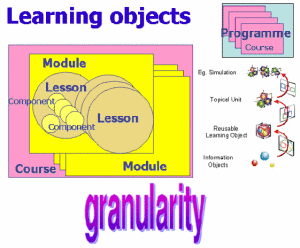Reusability, Standards, and Learning Objects
Much effort has been put into the technical reuse of electronically based teaching materials and in particular creating or re-using Learning Objects. These are self-contained units that are properly tagged with keywords, or other metadata, and often stored in an Extensible Markup Language (XML) file format. Creating a course requires putting together a sequence of learning objects. There are proprietary and open, non-commercial and commercial, peer-reviewed repositories of learning objects such as the Merlot repository.
A common standard format for e-learning content is SCORM. Other specifications allow for the transporting of “Learning Objects” (Schools Framework) or categorizing Learning Objects Metadata (LOM).
These standards themselves are early in the maturity process with the oldest being 8 years old. They are also relatively vertical specific: SIF is primarily pK-12, LOM is primarily Corp, Military and Higher Ed, and SCORM is primarily Military and Corp with some Higher Ed., the Post-Secondary Education Standards Council (PESC), is also making headway in developing standards and learning objects for the Higher Ed space, while SIF is beginning to seriously turn towards Instructional and Curriculum learning objects.
In the US pK12 space there are a host of content standards that are critical as well- the NCES data standards are a prime example. Each state government’s content standards and achievement benchmarks are critical metadata for linking e-learning objects in that space.
An excellent example of e-learning that relates to knowledge management and reusability is Navy E-Learning, which is available to Active Duty, Retired, or Disable Military members. This on-line tool provides certificate courses to enrich the user in various subjects related to military training and civilian skill sets. The e-learning system not only provides learning objectives, but also evaluates the progress of the student and credit can be earned toward higher learning institutions. The Internet allows for learning to be directed at one’s current objectives. This reuse is an excellent example of knowledge retention and the cyclical process of knowledge transfer and use of data and records. Wikipedia

Recent Comments